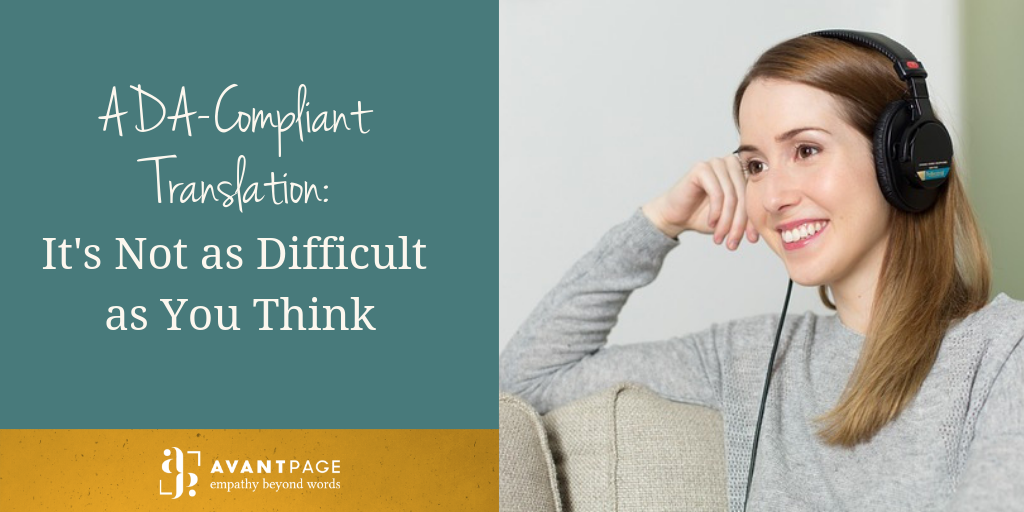ADA translation is based on the requirements of the Americans with Disabilities Act (ADA), which was implemented in 1990. The Americans with Disabilities Act (ADA) became law in 1990. The ADA is a civil rights law that prohibits discrimination against individuals with disabilities in all areas of public life, including jobs, schools, transportation, and all public and private places that are open to the general public. The ADA lays out guidelines for how organizations must communicate with those who have disabilities which may prevent them from engaging effectively with written or verbal information.
What is involved in ADA-compliant translation
Dependent on the needs of your target audience, there are different kinds of ADA-compliant translation that your organization will need to pursue. ADA-compliant translation is used specifically to ensure those who have vision, hearing, or speech disabilities – all falling under “communication disabilities” – are able to engage with the information you’re giving them in a meaningful way.
If your target audience includes people who are blind, have vision loss, or are deaf-blind, your ADA-compliant translation projects will need to include either large print formatting, braille translation, or links to audio filed reading the text aloud. Large print formatting takes the text from your translated document and optimizes it to accommodate those with vision loss. This formatting is specifically designed to reduce eye strain, which can improve the accessibility of your documents for those with vision loss. Braille translation involves the process of taking the text from your source document and translating/formatting it appropriately in braille, giving those with vision loss or blindness the ability to access the information in your document. In addition to making the text available to sight-impaired users, ADA-compliant translation should address graphics contained in your content. This can be achieved by embedding descriptors of any illustrations, charts, or graphs in-language and following the same ADA-compliant format as the text itself.
If your target audience includes people who are deaf, have hearing loss, or are deaf-blind, your ADA-compliant translation projects will need to include access to qualified sign language or oral interpreters, dependent on the individual’s needs. Similarly, if your target audience includes those with speech disabilities, you’ll need to provide a speech-to-speech transliterator or an effective communication board device. Interpreters can be provided in-person, over-the-phone, or via video chat as long as the interpreters are qualified and the method of interpretation is accessible to your target audience.
Who needs to complete ADA translation
ADA-compliant translation is necessary for all domains and mandated in many. The Americans with Disabilities Act encompasses five titles: Employment Rights, Public Services, Public Accommodations, Telecommunications, and Miscellaneous. Regardless of whether you frequently see people with disabilities in your organization, you need to be prepared to provide accessible documentation.
Organizations that are federally required to provide translated documents are also federally required to follow all suggestions of the ADA, including those laid out for ADA-compliant translation projects. Professionals in the fields of education, elections, healthcare, government, and other regulated fields must be prepared to provide ADA accessible documents when needed.
The ADA works to make communication effective for those who have communications disabilities, and paying attention to ADA-compliant translation projects can help you to avoid significant penalties from non-compliance. Our highly trained team can help you get started with ADA-compliant translation projects, ensuring your documents are accessible and that you’re in compliance. Give us a call at 530-750-2040 or request a free quote today.
GET VALUABLE CONTENT DELIVERED STRAIGHT TO YOUR INBOX. SIGN UP FOR OUR NEWSLETTER TODAY!

Ash is the Marketing Coordinator at Avantpage, Inc. Ash works to create high-value, targeted content that allows consumers to connect with us at Avantpage. They are a strong proponent of everyone having equal access to communication and information. They have written and created content for a variety of online platforms, and have been published in over 30 online platforms with varying topics. But Ash is other things too! An avid athlete, Ash enjoys spending their free time rock climbing, partaking in aerial circus sports, and practicing acroyoga.
